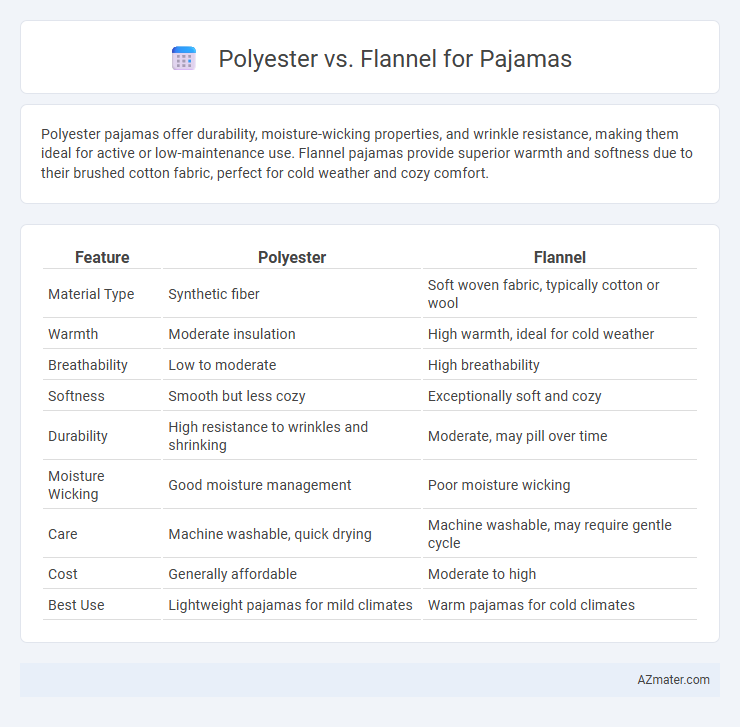Polyester pajamas offer durability, moisture-wicking properties, and wrinkle resistance, making them ideal for active or low-maintenance use. Flannel pajamas provide superior warmth and softness due to their brushed cotton fabric, perfect for cold weather and cozy comfort.
Table of Comparison
| Feature | Polyester | Flannel |
|---|---|---|
| Material Type | Synthetic fiber | Soft woven fabric, typically cotton or wool |
| Warmth | Moderate insulation | High warmth, ideal for cold weather |
| Breathability | Low to moderate | High breathability |
| Softness | Smooth but less cozy | Exceptionally soft and cozy |
| Durability | High resistance to wrinkles and shrinking | Moderate, may pill over time |
| Moisture Wicking | Good moisture management | Poor moisture wicking |
| Care | Machine washable, quick drying | Machine washable, may require gentle cycle |
| Cost | Generally affordable | Moderate to high |
| Best Use | Lightweight pajamas for mild climates | Warm pajamas for cold climates |
Introduction to Pajama Fabric Choices
Polyester pajamas offer durability, wrinkle resistance, and moisture-wicking properties, making them ideal for year-round comfort and easy maintenance. Flannel pajamas provide exceptional warmth and softness, crafted from brushed cotton or wool fibers, perfect for colder climates or cozy indoor wear. Choosing between polyester and flannel depends on temperature preferences, skin sensitivity, and care requirements.
What is Polyester?
Polyester is a synthetic fiber made from petroleum-based products known for its durability, wrinkle resistance, and moisture-wicking properties. It retains color well and dries quickly, making it a popular choice for pajamas that require easy care and longevity. Unlike flannel, polyester pajamas often feel smoother and less insulating, offering a lightweight option suitable for warmer climates.
What is Flannel?
Flannel is a soft, woven fabric typically made from cotton, wool, or synthetic fibers, known for its brushed texture that provides warmth and comfort. Its insulating properties make it an ideal choice for pajamas in colder climates, offering breathability and moisture-wicking benefits. Unlike polyester, flannel is naturally absorbent and less likely to cause overheating, enhancing overall sleep quality during chilly nights.
Comfort and Softness Comparison
Flannel pajamas excel in comfort due to their natural cotton fibers, providing exceptional softness and warmth, ideal for colder nights. Polyester pajamas offer a smooth, lightweight feel with moisture-wicking properties, making them breathable and suitable for warmer climates. While flannel is favored for its plush texture and insulation, polyester stands out for its durability and easy-care benefits without compromising on softness.
Breathability and Temperature Regulation
Polyester pajamas offer limited breathability due to their synthetic fibers, trapping heat and moisture, which can lead to discomfort during warm nights. Flannel, made from natural cotton or wool fibers, excels in temperature regulation by providing warmth while allowing better airflow, making it suitable for cooler sleeping environments. Choosing flannel ensures enhanced moisture-wicking properties, promoting a comfortable and dry sleep compared to the less breathable polyester options.
Durability and Longevity
Polyester pajamas offer high durability due to their synthetic fibers, resisting shrinking, wrinkling, and abrasions, which ensures long-lasting wear. Flannel pajamas, made from cotton or wool, provide warmth but may degrade faster with frequent washing and can pill over time. Choosing polyester enhances longevity for regular use, while flannel suits cozy, less-intensive wear patterns.
Care and Maintenance Requirements
Polyester pajamas require minimal care, typically machine washable with quick drying times and resistance to wrinkles, making them low-maintenance. Flannel pajamas demand more delicate handling, often needing cold water wash cycles and air drying to prevent shrinkage and maintain fabric softness. Proper care for flannel includes avoiding high heat to preserve the fabric's warmth and texture, while polyester can withstand higher temperatures without damage.
Allergy and Skin Sensitivity Factors
Polyester pajamas often cause irritation and allergic reactions due to synthetic fibers that trap heat and moisture, aggravating sensitive skin. Flannel, made from natural cotton or wool, provides breathability and softness, reducing the risk of rashes and dermatitis in individuals prone to allergies. Hypoallergenic properties of flannel make it a preferred choice for those with sensitive skin seeking comfortable nighttime wear.
Price and Value Differences
Polyester pajamas generally offer a lower price point compared to flannel, making them a budget-friendly option for consumers seeking affordable sleepwear. The synthetic nature of polyester provides durability and moisture-wicking properties, enhancing overall value despite its lower cost. Flannel pajamas, typically made from cotton or wool, tend to be more expensive but deliver superior warmth and breathability, offering greater comfort and long-term value in colder climates.
Which is Better: Polyester or Flannel for Pajamas?
Polyester pajamas offer durability, wrinkle resistance, and moisture-wicking properties, making them ideal for active sleepers and easy maintenance. Flannel pajamas provide superior warmth, softness, and breathability, perfect for cold weather and comfort seekers. Choosing between polyester and flannel depends on personal preference for warmth versus moisture management and ease of care.

Infographic: Polyester vs Flannel for Pajama
 azmater.com
azmater.com